Low CD4/CD8 T-cell ratio associated with inflammatory arthropathy in human T-cell leukemia virus type I Tax transgenic mice
- PMID: 21483764
- PMCID: PMC3069963
- DOI: 10.1371/journal.pone.0018518
Low CD4/CD8 T-cell ratio associated with inflammatory arthropathy in human T-cell leukemia virus type I Tax transgenic mice
Abstract
Background: Human T-cell leukemia virus type I (HTLV-1) can cause an aggressive malignancy known as adult T-cell leukemia/lymphoma (ATL) as well as inflammatory diseases such as HTLV-1-associated myelopathy/tropical spastic paraparesis (HAM/TSP). A transgenic mouse that expresses HTLV-1 Tax also develops T-cell leukemia/lymphoma and an inflammatory arthropathy that resembles rheumatoid arthritis. The aim of this study was to identify the primary T-cell subsets involved in the development of arthropathy in Tax transgenic mice.
Principal findings: By 24 months of age, Tax transgenic mice developed severe arthropathy with a cumulative incidence of 22.8%. The pathological findings of arthropathy in Tax transgenic mice were similar to those seen in human rheumatoid arthritis or mouse models of rheumatoid arthritis, with synovial proliferation and a positive rheumatoid factor. Before the onset of spontaneous arthropathy, young and old Tax transgenic mice were not sensitive to collagen and did not develop arthritis after immunization with type II collagen. The arthropathic Tax transgenic mice showed a significantly decreased proportion of splenic CD4(+) T cells, whereas the proportion of splenic CD8(+) T cells was increased. Regulatory T cells (CD4(+)CD25(+)Foxp3(+)) were significantly decreased and CD8(+) T cells that expressed the chemokine receptor CCR4 (CD8(+)CCR4(+)) were significantly increased in arthropathic Tax transgenic mice. The expression of tax mRNA was strong in the spleen and joints of arthropathic mice, with a 40-fold increase compared with healthy transgenic mice.
Conclusions: Our findings reveal that Tax transgenic mice develop rheumatoid-like arthritis with proliferating synovial cells in the joints; however, the proportion of different splenic T-cell subsets in these mice was completely different from other commonly used animal models of rheumatoid arthritis. The crucial T-cell subsets in arthropathic Tax transgenic mice appear to resemble those in HAM/TSP patients rather than those in rheumatoid arthritis patients.
Conflict of interest statement
Figures
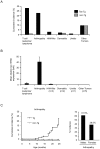


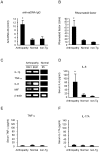
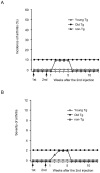
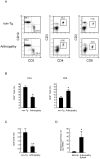
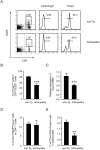

Similar articles
-
Adult T-cell leukemia-lymphoma as a viral disease: Subtypes based on viral aspects.Cancer Sci. 2021 May;112(5):1688-1694. doi: 10.1111/cas.14869. Epub 2021 Mar 30. Cancer Sci. 2021. PMID: 33630351 Free PMC article. Review.
-
Invasion of histiocytic sarcoma into the spinal cord of HTLV-1 tax transgenic mice with HTLV-1-associated myelopathy/tropical spastic paraparesis-like disease.Oncol Res. 2013;20(9):403-10. doi: 10.3727/096504013X13657689383058. Oncol Res. 2013. PMID: 23924924
-
IFN-gamma production in response to Tax 161-233, and frequency of CD4+ Foxp3+ and Lin HLA-DRhigh CD123+ cells, discriminate HAM/TSP patients from asymptomatic HTLV-1-carriers in a Peruvian population.Immunology. 2009 Sep;128(1 Suppl):e777-86. doi: 10.1111/j.1365-2567.2009.03082.x. Epub 2009 Feb 17. Immunology. 2009. PMID: 19740339 Free PMC article.
-
Expression of murine HOXD9 during embryonic joint patterning and in human T lymphotropic virus type I tax transgenic mice with arthropathy resembling rheumatoid arthritis.Arthritis Rheum. 1999 Apr;42(4):686-96. doi: 10.1002/1529-0131(199904)42:4<686::AID-ANR11>3.0.CO;2-O. Arthritis Rheum. 1999. PMID: 10211882
-
HTLV-1-associated myelopathy/tropical spastic paraparesis (HAM/TSP) inflammatory network.Inflamm Allergy Drug Targets. 2008 Jun;7(2):98-107. doi: 10.2174/187152808785107642. Inflamm Allergy Drug Targets. 2008. PMID: 18691139 Review.
Cited by
-
Myeloid cell expressed proprotein convertase FURIN attenuates inflammation.Oncotarget. 2016 Aug 23;7(34):54392-54404. doi: 10.18632/oncotarget.11106. Oncotarget. 2016. PMID: 27527873 Free PMC article.
-
Ripasudil as a Potential Therapeutic Agent in Treating Secondary Glaucoma in HTLV-1-Uveitis: An In Vitro Analysis.Int J Mol Sci. 2024 Mar 12;25(6):3229. doi: 10.3390/ijms25063229. Int J Mol Sci. 2024. PMID: 38542203 Free PMC article.
-
Effects of expressing human T-cell leukemia virus type 1 (HTLV-I) oncoprotein Tax on DOK1, DOK2 and DOK3 gene expression in mice.J Vet Med Sci. 2017 May 23;79(5):935-938. doi: 10.1292/jvms.17-0034. Epub 2017 Mar 12. J Vet Med Sci. 2017. PMID: 28302940 Free PMC article.
-
Conference highlights of the 15th International Conference on Human Retrovirology: HTLV and related retroviruses, 4-8 June 2011, Leuven, Gembloux, Belgium.Retrovirology. 2011 Oct 28;8:86. doi: 10.1186/1742-4690-8-86. Retrovirology. 2011. PMID: 22035054 Free PMC article.
-
Adult T-cell leukemia-lymphoma as a viral disease: Subtypes based on viral aspects.Cancer Sci. 2021 May;112(5):1688-1694. doi: 10.1111/cas.14869. Epub 2021 Mar 30. Cancer Sci. 2021. PMID: 33630351 Free PMC article. Review.
References
-
- Watanabe T. HTLV-1-associated diseases. Int J Hematol. 1997;66:257–278. - PubMed
-
- Verdonck K, Gonzalez E, Van Dooren S, Vandamme AM, Vanham G, et al. Human T-lymphotropic virus 1: recent knowledge about an ancient infection. Lancet Infect Dis. 2007;7:266–281. - PubMed
-
- Grassmann R, Aboud M, Jeang KT. Molecular mechanisms of cellular transformation by HTLV-1 Tax. Oncogene. 2005;24:5976–5985. - PubMed
-
- Matsuoka M, Jeang KT. Human T-cell leukaemia virus type 1 (HTLV-1) infectivity and cellular transformation. Nat Rev Cancer. 2007;7:270–280. - PubMed
Publication types
MeSH terms
Substances
LinkOut - more resources
Full Text Sources
Other Literature Sources
Medical
Molecular Biology Databases
Research Materials
Miscellaneous

